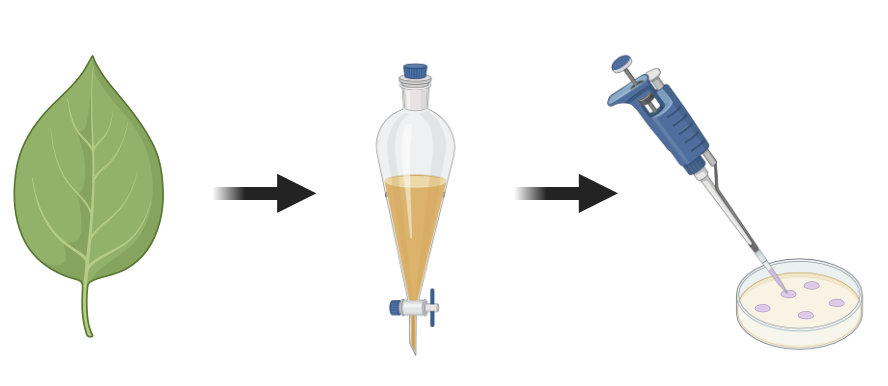In-Vitro Antibacterial Bioassay of Methanol Extract Fraction (Rf > 0.5) from Rhizophora mucronata L. (Rhizophoraceae) Leaves Against Multidrug-Resistant Escherichia coli
Main Article Content
Abstract
A bioactivity study was conducted in January 2018 on the methanolic extract (Rf > 0.5) of mangrove leaves from Rhizophora mucronata L. (Rhizophoraceae) targeting resistant Escherichia coli. Secondary metabolites were isolated at the Marine Chemical Laboratory, Faculty of Marine and Fisheries, while antibacterial testing was performed at the Microbiology Laboratory, Faculty of Medicine, Syiah Kuala University. Using thin layer chromatography, bioactive fractions were identified, and phytochemical screening confirmed the presence of alkaloids. The extract demonstrated inhibition zones between 7.50–8.50 mm, indicating moderate antibacterial activity against resistant E. coli.
Article Details

This work is licensed under a Creative Commons Attribution 4.0 International License.
References
1. Amirkaveei, S.; Behbahani, B.A. Antimicrobial effect of mangrove extract on Escherichia coli and Penicillium digita-tum. In Proceedings of the International Conference on Food Engineering and Biotechnology, Singapore, 2011; IP-CBEE 9, 185–188.
2. Astarina, N.W.G.; Astuti, K.W.; Warditiani, N.K. Phytochemical screening of methanol extract of Bangle rhizome (Zin-giber purpureum Roxb.). J. Farm. Udayana 2013.
3. Bobbarala, V. Antimicrobial Agents. Intech: Croatia, 2012.
4. Bombardelli, E. Technologies for the Processing of Medicinal Plants. In The Medicinal Plant Industry, Wijesekera, R.O.B., Ed.; CRC Press: Boca Raton, FL, USA, 1991, 185–196.
5. Darsana, I.G.O. The potential of Binahong leaves (Anredera cordifolia) in inhibiting the growth of Escherichia coli bacteria in vitro. Indonesia Medicus Veterinus 2012 1(3), 337–351.
6. Davis, W.W.; Stout, T.R. Disc plate methods of microbiological antibiotic assay. Microbiology 1971, 22, 659–665.
7. Djoepri, M.R. Isolation and identification of Escherichia coli microbes in sausage and nugget foods. Animal Hus-bandry Research and Development Center, Center for Veterinary Research, 2006, 265–268.
8. Harborne, J.B. Phytochemical Methods, 2nd ed.; Padmawinata, K., Trans.; Bandung Institute of Technology, Ban-dung, Indonesia, 1987, 58-84.
9. Kang, S.G.; Park, H.U.; Lee, H.S.; Kim, H.T.; Lee, K.J. New β-lactamase inhibitory protein (BLIP-1) from Streptomyces exfoliates SMF 19 and its roles on morphological differentiation. J. Biol. Chem. 275 (22), 16851–16856, 2000.
10. Karlina, C.Y.; Muslimin, I.; Guntur, T. Antibacterial activity of herb Portulaca oleracea L. extract against Staphylo-coccus aureus and Escherichia coli. J. LenteraBio 2013, 2(1), 87–93.
11. Karsinah. Gram-negative bacteria. In Medical Microbiology; Sujudi, H., Ed.; Bina Rupa Aksara: Jakarta, Indonesia, 1994, 35-63.
12. Kosala, K. Antibacterial activity of ethanol extract of Vitex pinnata leaves against diarrhea-causing bacteria using disk diffusion method. Thesis, Faculty of Medicine, University of Mulawarman, Samarinda, Indonesia, 2010.
13. Kuette, C. Antimicrobial activities of methanol extract and compounds from Artocarpus communis. BMC Comple-ment. Altern. Med. 2011, 11, 42.
14. Mbah, J.A.; Ngemennya, M.N.; Abawah, A.L.; Babiaka, S.B.; Nubed, L.N.; Nyongbela, K.D.; Lemuh, N.D.; Efange, S.M.N. Antimicrobial agents. Ann. Clin. Microbiol. Antimicrob. 2012, 11, 1-10.
15. Pimpliskar, M.R.; Jadhav, R.N.; Jadhav, B.L. Study on antimicrobial principles of Rhizophora species along Mumbai coast. J. Aqua Biol. 2011, 26 (1), 6–11.

